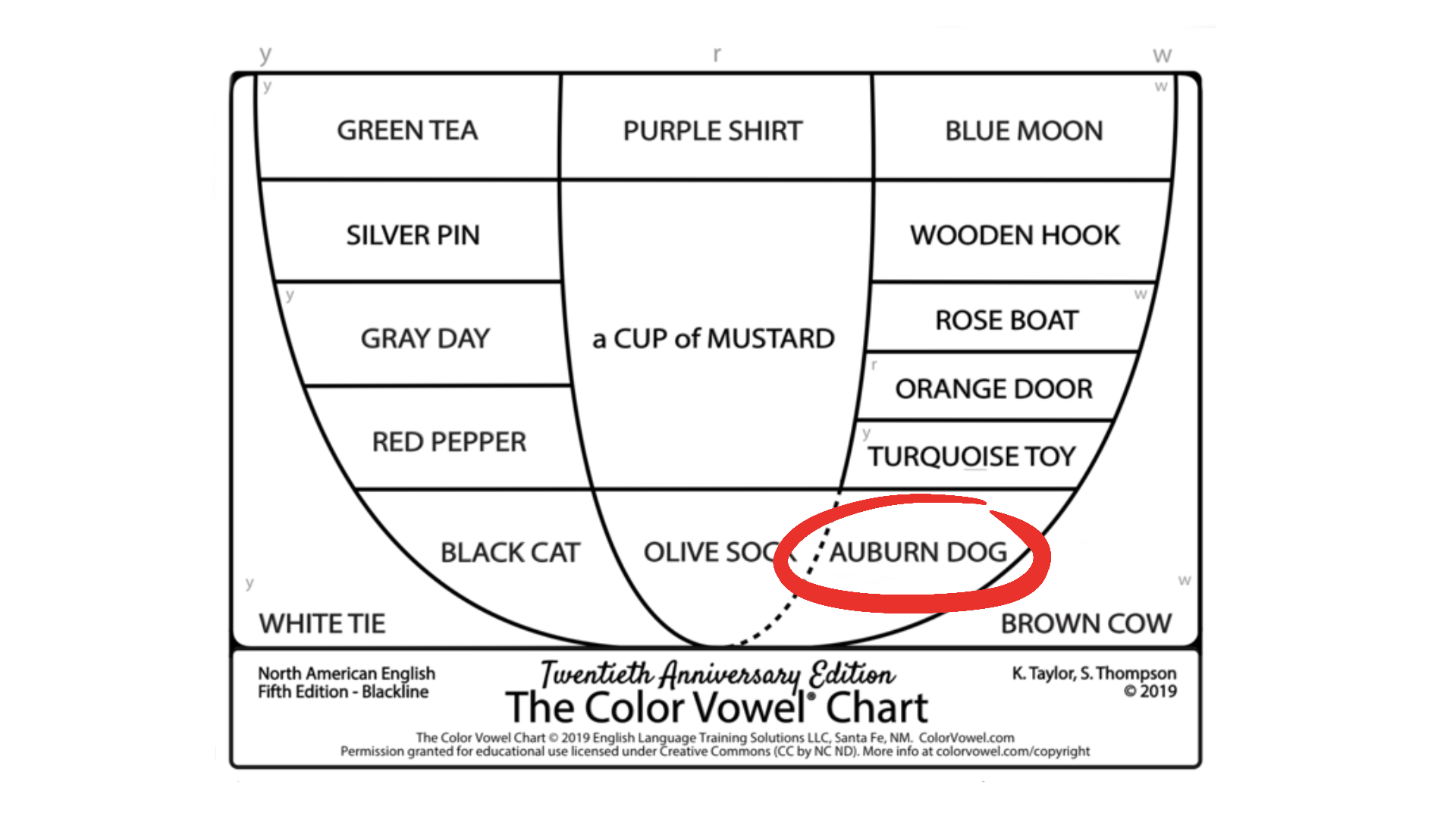The AH-Sound
We’re talking about the AH-sound now.
This open back unrounded vowel, or low back unrounded vowel, is represented by the letter ‘a’ - but the script A form, not the printed A form.
The International Phonetic Alphabet (IPA) symbol for this sound is /ɑ/.
In General American English and Canadian English, the [ɑ] sound is the sound in the word ‘FATHER’ or ‘POT’
SYMBOL
On the IPA vowel chart, it is located on the bottom right of the chart.
The Color Vowel® Chart, created by Karen Taylor and Shirley Thompson in 1999, is another visual organizer for spoken English and represents how to learn and think about vowels. It refers to this sound as the ‘AUBURN DOG’ sound or the AUBURN vowel. Notice the consistent placement on the mid-right corner of each respective chart.
The Color Vowel® Chart, 5th Edition © 2019. ColorVowel.com. Used with Creative Commons licensing (CC BY-NC-ND).
SOUND
So, the AH-sound in FATHER is characterized by two key things. It is produced low in the mouth so the mouth is quite open for the sound. So drop the jaw. Secondly, the vowel is produced in the back of the mouth. You should focus on the sound coming from the back of the mouth, like you’re making sound during a big yawn.
Air escapes from the mouth only, not from the nose, and the tongue is largely in neutral resting position.
For UK English speakers, this sound is also used for words like ‘PAST’, ‘FAST, and ‘LAST’. But North American English speakers will not use this AH-sound. Instead, North American English speakers will use the AA-sound in ‘BAT’.
FEATURES
The [ɑ] sound features are as follows.
Its vowel height is open, also known as low, which means the tongue is positioned far from the roof of the mouth – that is, low in the mouth.
Its vowel backness is back, which means the tongue is positioned back in the mouth without creating a constriction that would be classified as a consonant. Unrounded back vowels tend to be centralized, which means that often they are in fact near-back.
It is unrounded, which means that the lips are not rounded.
VISUAL REPRESENTATION
In English, the [ɑ] sound is reflected in spelling in many different ways. Depending on the specific English dialect, it may be written using any of the following letters:
a - father, paw, draw, spa, bylaw
o - body, lock, job, October, shot, gone, cross, song, pop, crossed, robber, coffee, office,
e - sergeant
ou - cough
ua - squab
The reason why I’m especially showing you the different spelling combinations that can create this sound is that there will ALWAYS be exceptions, weird spellings, or other things that impact how reliable the written representation will be.
LISTENING
You need to be able to identify the sound; rhyming is an excellent way to match it properly. So, if you are not good already, start practicing rhyming and hearing the sound.
| EE | IH |
AY | EH |
AA | UH | AH |
|---|---|---|---|---|---|---|
| bean | bin | bane | Ben |
ban | bun | bon |
| reed | rid | raid | red | rad | rudd | rod |
| teak | tick | take | tech | tack | tuck | tock |
I’m breaking down every single sound down for you so that you can learn how to produce each sound in English accurately. Sometimes, we’ll have easier sounds and sometimes we’ll have harder sounds.
If you’ve grasped this sound, then great! But if you’ve got a tip that might work for others, or you took a while to produce this sound correct but something clicked for you, let me know down below in the comments. My goal is to have a community know what to do when they’re stuck!



